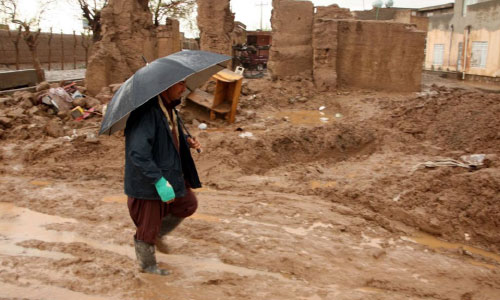Last Thursday and Friday the west and north provinces of the country were severely damaged with heavy rainfall and flood spate. These floods have badly affected across seven provinces, especially Herat, Balkh, Faryab and Badghis. According to the Local authorities, the event caused 35 deaths and many more have been wounded in northern and western Afghanistan. Of these, 12 have killed in Faryab, 10 in the western province of Heart, 8 in Badghis and 5 other in Balkh. In addition, Another 12 people were missing and more than 700 houses were destroyed or severely damaged which caused thousands of family displacement. “There is huge destruction caused by floods,” quoted from Ahmad Jawed Nadem, head of refugees and repatriation for Herat. In one area, he said he saw more than 200 destroyed houses. The ministry of dealing with natural disasters predicts farther persistence of heavy rainfall in the coming weeks.
The floods worsened an already desperate drought hit and war-torn situation. Earlier this month, were also killed at least 20 people by flash floods caused by heavy rains that swept away thousands of homes and vehicles in southern Kandahar province. Hundreds of thousands of people remained displaced as a result of last year’s severe drought across 22 provinces of the country. Floods in early March also caused destruction and put this year’s wheat harvest at risk. Children waded through muddy, knee-deep floodwaters that flowed through tent camps for displaced people after the rain stopped. Mir Gulabuddin Miri, director of the Afghan Red Crescent in Herat, said access to some areas had been cut off, preventing teams from reaching affected people. “The destruction is huge. Over 12 areas in the province have been badly hit, people have lost their houses. We’ve only been able to provide them with some food and blankets so far,” he said. Some Badghis residents were calling it the worst storm in 20 years, it said.
Given the past and present natural disasters, it seems that Afghanistan is country which always subject to danger of flood spate. The 21 provinces of Afghanistan are more vulnerable to floods and landslides, and there is a greater risk in areas of eastern and north-eastern provinces. Seasonally, Afghanistan is more vulnerable against natural disasters such as earthquakes, landslide, storms, floods and severe snowstorms during the winter and spring season. Despite above mentioned fact, being one of the countries with a high probability in occurrence of natural disasters, the government and the people of Afghanistan have no readiness to deal with natural disasters and are often shocked, and the number of victims is also highly increased. This trend has increasingly intensified simultaneous with general climate change in several last year.
However, the ministry of dealing with natural disasters is active in dealing with natural incidents but it has not the capacity to deal with such huge disasters, and so has failed to appropriately respond or prevent natural disasters. The activities of this ministry are limited to the relief and treatment of the injured after the incident; therefore, it has been less successful in awaking people or taking necessary measures before incident. Failure to provide timely information is one of the main challenges of combating natural disasters in Afghanistan. Timely information is one of the essential prerequisites for success in combating natural disasters. Unfortunately, In Afghanistan, beside the fact that students at school and universities are not trained on dealing with natural disasters, there is no public awareness in this area and people are not told what to do when a natural incident occurs. They do not know how to help each other to prevent from increase of human casualties and fiscal losses.
In other countries, there is always a previous alert system for such incidents. But in Afghanistan, unfortunately, there is no such system and the citizens of Afghanistan have not received any information about the probability of a natural accident in the foreseeable future. Thus, after the occurrence of natural events, timely assistance is not provided. In recent years, it has been seen that responsible institutions have began helping several days after the incident occurred. Failure to provide timely assistance indicates that the Afghan government is not prepared to combat natural disasters, which will increase the casualties and losses caused by such incidents.
Seemingly, there is also Managerial and technical weakness in dealing with natural events. As seen in recent years, many government ministry staffs did not have sufficient skill and expertise in combating natural disasters. To have a successful fight against natural disasters, the government of Afghanistan needs to make a specialized ministry with modern equipment and facilities. Meanwhile, the ministry should have plans to raise awareness of people how to deal with such incidents and show people how to take probable measures in the event of such incidents.
Moreover, it is imperative upon the government of Afghanistan to predict and be able to manage any type climate incident may occur in the future. According to experts the implementation of Afghanistan National Development Strategy, the country’s second most important national document after the Constitution, would be the best way to overcome the climate issues. However, some parts of this document has received enough government’s attention like building water infrastructure but within ANDS the country’s agricultural sector and climate change issue must be given more priority and climate change effect should not be neglected.
Home » Opinion » Necessity for Preventive Measures Against Natural Disasters
Necessity for Preventive Measures Against Natural Disasters
| Mohammad Zahir Akbari

